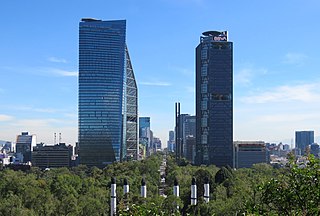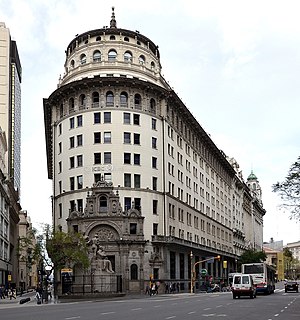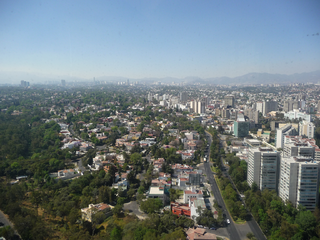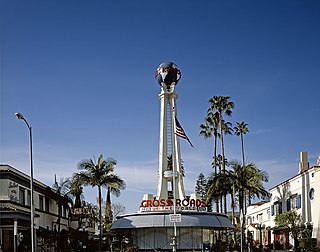
Mexico City is the capital and largest city of Mexico, and the most populous city in North America. It is one of the country's 32 federal entities. Mexico City is one of the most important cultural and financial centers in the world. It is located in the Valley of Mexico in the high central plateau, at an altitude of 2,240 meters (7,350 ft). The city has 16 boroughs or demarcaciones territoriales, which are in turn divided into neighborhoods or colonias.

Paseo de la Reforma is a wide avenue that runs diagonally across the heart of Mexico City. It was designed at the behest of Emperor Maximilian by Ferdinand von Rosenzweig during the era of the Second Mexican Empire and modeled after the great boulevards of Europe, such as the Ringstraße in Vienna and the Champs-Élysées in Paris. The planned grand avenue was to link the National Palace with the imperial residence, Chapultepec Castle, which was then on the southwestern edge of town. The project was originally named Paseo de la Emperatriz in honor of Maximilian's consort Empress Carlota. After the fall of the Empire and Maximilian's subsequent execution, the restored Restored Republic renamed the Paseo in honor of the La Reforma.

The Spanish Colonial Revival Style is an architectural stylistic movement arising in the early 20th century based on the Spanish Colonial architecture of the Spanish colonization of the Americas.

Miguel Hidalgo is a borough in the Mexico City. It was created in 1970 when central Mexico City was divided into four boroughs. Miguel Hidalgo joined the historic areas of Tacuba, Chapultepec and Tacubaya along with a number of notable neighborhoods such as Polanco and Lomas de Chapultepec. With landmarks such as Chapultepec Park and the Museo Nacional de Antropología, it is the second most visited borough in Mexico City after Cuauhtémoc where the historic center of Mexico City is located. Tacubaya and Tacuba both have long histories as independent settlements and were designated as “Barrios Mágicos” by the city for tourism purposes.

Spanish Colonial architecture represents Spanish colonial influence on New World and East Indies' cities and towns, and it is still being seen in the architecture as well as in the city planning aspects of conserved present-day cities. These two visible aspects of the city are connected and complementary. The 16th-century Laws of the Indies included provisions for the layout of new colonial settlements in the Americas and elsewhere.

Colonia Roma, also called La Roma or simply, Roma, is a district located in the Cuauhtémoc borough of Mexico City just west of the city's historic center, and in fact is no longer a single colonia (neighbourhood) but now two officially defined ones, Roma Norte and Roma Sur, divided by Coahuila street.

El Puerto de Liverpool S.A. de C.V., commonly known as Liverpool, is a mid-to-high end retailer which operates the largest chain of department stores in Mexico. It operates 136 stores under the Liverpool name, 131 stores under the Suburbia name, and 27 shopping centers, including Perisur and Galerías Monterrey.

Lomas de Chapultepec is a colonia, or officially recognized neighborhood, located in the Miguel Hidalgo borough of Mexico City. It dates back to the 1920s, when it was founded with the name Chapultepec Heights. Home to some of the biggest mansions in the city and many high-net-worth individuals, it has gained a reputation of exclusivity. Its main entrance is through Paseo de la Reforma.

Avenida Presidente Masaryk is a thoroughfare in the affluent Polanco neighborhood of Mexico City. It stretches from Calzada General Mariano Escobedo in the east to Avenida Ferrocarril de Cuernavaca in the west, passing along the north side of the Polanquito restaurant district that borders Parque Lincoln. Masaryk is one of the most expensive shopping districts in the world and competes with Avenida Madero in the Historic Center for the title of street with the highest rents in the city.

Polanco is a station of the Mexico City Metro in Miguel Hidalgo, Mexico City. It is an underground station with two side platforms served by Line 7 between San Joaquín and Auditorio stations. It serves the colonia (neighborhood) of Polanco and it is named after it; the pictogram depicts the clock tower located at the nearby Lincoln Park. Polanco station opened on 20 December 1984 with service northward toward Tacuba and southward toward Auditorio. In 2019, the station had an average daily ridership of 35,694 passengers, making it the 24th busiest station in the network and the third busiest of the line.

Polanco is a neighborhood in the Miguel Hidalgo borough of Mexico City. Polanco is an upscale colonia, noted for its luxury shopping along Presidente Masaryk Avenue, the most expensive street in Mexico, as well as for the numerous prominent cultural institutions located within the neighborhood, such as the Museo Soumaya and the Colección Jumex. Polanco is often called the "Beverly Hills of Mexico", having one of the country's densest concentrations of luxury shopping, with the most upscale restaurants, high-net-worth individuals, upscale hotels, and diplomatic missions and embassies. It is one of the most expensive real estate markets in Latin America.

Many of Mexico's older architectural structures, including entire sections of Pre-Hispanic and colonial cities, have been designated World Heritage sites for their historical and artistic significance. The country has the largest number of sites declared World Heritage Sites by UNESCO in the Americas.
Francisco J. Serrano y Alvarez de la Rosa was a Mexican civil engineer and architect.

The Houses of the Mayorazgo de Guerrero are historic buildings at 16 and 18 Moneda Street in Mexico City, located across from the Museum of Cultures in the historic center of the city and near Correo Mayor.

Nuevo Polanco is an area of Mexico City formerly consisting of warehouses and factories, bordering the upscale Polanco on the north across Avenida Ejército Nacional. Officially it consists of two colonias, Granada and Ampliación Granada.

Colonia Nápoles is a colonia, is an officially recognized neighborhood in Benito Juárez borough, Mexico City, and one of the iconic Mid-Century neighborhoods of Mexico City along with Colonia Del Valle.
Colegio Ciudad de México is a private school network in Mexico City, Mexico. It has two campuses: Plantel Contadero in Cuajimalpa, and Plantel Polanco.
Miyana is a mixed-use residential and commercial development of Gigante Grupo Mobiliario in Nuevo Polanco district of Mexico City. It is located on a 43,501 square metres (468,240 sq ft) lot with 520,000 square metres (5,600,000 sq ft), making it one of the largest such developments in the metropolis, with an investment of 7 billion pesos.

Colonia Verónica Anzures is a colonia of Mexico City located in the Miguel Hidalgo borough. The neighborhood is a residential area but it also houses some office buildings, most importantly the Torre Ejecutiva Pemex.

A shopping court is a type of neighborhood shopping center that developed, particularly in Greater Los Angeles, in the 1920s. Most had a few boutiques, themed shops, and cafes, up to a dozen and sometimes included offices and studios. A linear walkway or patio connected the units, which was relatively new, as up to then, collections of shops under a management or coordination were connected by a public sidewalk, as in Westwood Village or Country Club Plaza. Patios of buildings in Mexico, Latin America and the Mediterranean inspired the design on the shopping court, as those regions also inspired much of the Southern California architecture during that era, e.g. Spanish Colonial Revival architecture. Shopping courts proliferated in the 1930s in affluent residential areas such as Hollywood, Beverly Hills, and Pasadena, and in resorts like Palm Springs and Santa Barbara. They were limited in impact as the scale could not accommodate larger stores and store windows did not draw attention of passing motorists.

















